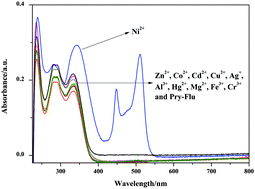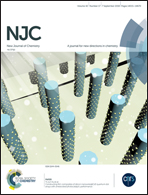Two novel pyrazole-based chemosensors: “naked-eye” colorimetric recognition of Ni2+ and Al3+ in alcohol and aqueous DMF media
Abstract
Two novel pyrazole-based chemosensors Pry-Flu and Pry-R6G were successfully synthesized, and their structures were confirmed by NMR spectroscopy and high-resolution mass spectroscopy (HRMS). The sensors Pry-Flu and Pry-R6G showed high selectivity and sensitivity toward Ni2+ and Al3+ over other competitive metal ions, respectively. Fluorescence investigation revealed that the sensor Pry-Flu could selectively coordinate with Ni2+ with a color change from colorless to orange-yellow, and the sensor Pry-R6G could be used for the specific detection of Al3+ with a color change from colorless to pink in mixed solvent (DMF/H2O, 1/99, v/v). In addition, the detection limits for Al3+ and Ni2+ were found to be as low as 2.61 × 10−8 and 1.87 × 10−8 M, respectively. The stoichiometric ratio of sensors toward the Ni2+/Al3+ ions was determined to be 1 : 1. The sensors Pry-Flu and Pry-R6G were also found to have a wide pH range (4–12) and short response time (1–3 min). Furthermore, the sensing mechanism was proposed based on chelation-enhanced fluorescence (CHEF) and investigated in detail by fluorescence spectroscopy, 1H NMR titrations and FT-IR.



 Please wait while we load your content...
Please wait while we load your content...